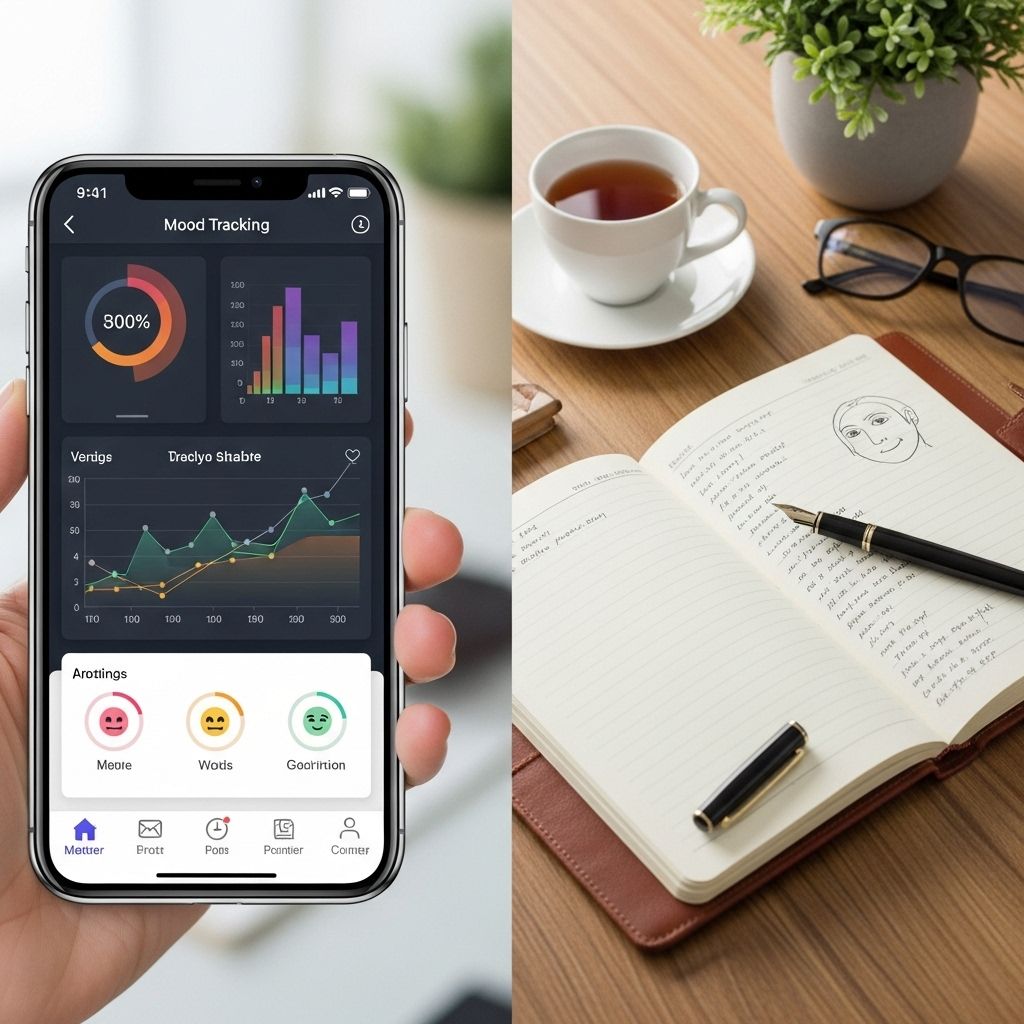Mood Tracking vs. Traditional Journaling for Insight
Capture emotional patterns by pairing quick entries with deeper freeform reflection.

Both mood tracking and traditional journaling are popular methods for enhancing emotional awareness and mental clarity. While they share some similarities, they differ significantly in their approaches and benefits. In this article, we will delve into the world of these two methods, comparing their features, advantages, and how they can be combined for optimal results.
## Table of Contents- [Introduction](#introduction)- [Understanding Mood Tracking](#understanding-mood-tracking)- [Understanding Traditional Journaling](#understanding-traditional-journaling)- [Mood Tracking vs. Traditional Journaling: Key Differences](#mood-tracking-vs-traditional-journaling-key-differences)- [Combining Both Methods](#combining-both-methods)- [Conclusion](#conclusion)- [FAQs](#faqs)## Introduction
Mental health is a critical aspect of our overall well-being, and maintaining emotional balance is essential in today’s fast-paced world. Two popular tools for achieving this are mood tracking and traditional journaling. Both methods have their unique benefits and cater to different preferences and needs.
## Understanding Mood Tracking
Mood Tracking: A Structured Approach
Mood tracking involves using apps or tools to log and analyze your mood over time. This method is highly structured and data-focused, allowing users to quickly record their emotions and identify patterns with ease. Mood tracking apps often provide features like mood ratings, tags, and visual summaries, making it easy to spot trends and emotional habits.
Benefits of Mood Tracking:-
Quick and Easy to Use
: Mood tracking is ideal for those who want a fast and consistent daily habit. It takes only a few minutes each day to log your mood.-Pattern Recognition
: The structured format helps in recognizing emotional patterns over time, which can be invaluable for personal growth.-Data Analysis
: Apps like Daylio and Bearable offer detailed insights and visual data to help users understand their emotional trends. Popular Mood Tracking Apps:-Daylio
: Known for its user-friendly interface and comprehensive features.-mindsmiles
: Offers a blend of mood tracking and guided journaling.-Bearable
: Provides a minimalist approach to mood recording.## Understanding Traditional JournalingTraditional Journaling: A Reflective Approach
Traditional journaling involves writing down your thoughts and feelings in a more freeform manner. This expressive method is often used for deep emotional processing, therapy, or personal reflection. Journaling can be done with pen and paper or through digital apps like Day One or Moodnotes.
Benefits of Traditional Journaling:-
Deep Emotional Processing
: Traditional journaling allows for a more profound exploration of emotions and can be a therapeutic tool.-Self-Awareness
: By writing about your experiences, you gain greater insight into your emotional patterns and triggers.-Creative Expression
: Journaling provides a space for creative freedom and reflection, which can be therapeutic. Popular Traditional Journaling Tools:-Pen and Paper
: Offers a tactile experience with complete privacy.-Day One
: A digital journaling app that provides prompts and tags for entries.-Moodnotes
: Offers guided reflection and mood tracking features.## Mood Tracking vs. Traditional Journaling: Key DifferencesComparing the Two Methods
While both methods aid in emotional awareness, they differ in format, time commitment, and the type of insights they provide. Here’s a summary of their key differences:
Key Differences Table| Feature | Mood Tracking | Traditional Journaling ||——————|———————————————|———————————-|| Format | Structured logs | Freeform writing || Time Commitment | Quick, ~30 seconds to 2 minutes | More time-consuming, 5-15+ minutes || Best For | Identifying patterns, recognizing trends | Deep emotional processing, self-awareness || Output | Visual data, patterns | Emotional clarity, insight |## Combining Both Methods
Blending the Best of Both Worlds
Many people find that combining mood tracking with traditional journaling provides the most comprehensive approach to emotional insight. Apps like mindsmiles offer a combination of quick mood entries and deeper reflective prompts, allowing users to start with simple tracking and delve into more profound reflection when needed.
Benefits of Combining:-
Comprehensive Insights
: Combining both methods allows for both quick pattern recognition and deep emotional exploration.-Flexibility
: Users can start with a simple tracking habit and expand to more in-depth journaling as they become more comfortable with the process.-Adaptability
: Combining methods can be tailored to fit individual preferences and schedules.## ConclusionBoth mood tracking and traditional journaling are valuable tools for understanding and managing emotions. By recognizing the unique benefits of each, individuals can choose the method (or combination) that best suits their lifestyle and emotional needs. Whether you prefer the structured approach of mood tracking or the reflective nature of traditional journaling, the key to success lies in consistency and personal preference.
## FAQs
Frequently Asked Questions
Q: What is the main difference between mood tracking and traditional journaling?
A: Mood tracking is a structured method focusing on quick logs and data analysis to identify emotional patterns, while traditional journaling is a more expressive and reflective approach aimed at deep emotional processing.
Q: Can I use both mood tracking and traditional journaling simultaneously?
A: Yes, combining both methods can be beneficial. Some apps, like mindsmiles, offer features that integrate quick mood tracking with deeper reflective journaling.
Q: Which method is better for spotting emotional trends?
A: Mood tracking is generally better for spotting trends due to its structured format and analytical features.
References
- https://mindsmiles.app/mood-journaling-vs-mood-tracking/
- https://www.pausa.co/blog/ai-journaling-vs-traditional-journaling
- https://emoodtracker.com/other-mood-trackers/mood-journal-anxiety-chat-vs-emoods
- https://pmc.ncbi.nlm.nih.gov/articles/PMC8387890/
- https://practicebetter.io/blog/why-mood-journals-are-the-key-to-revolutionary-client-care
- https://positivepsychology.com/mood-charts-track-your-mood/
- https://www.amahahealth.com/blog/how-to-start-journaling-mood-tracking-for-mental-health/
Read full bio of Sneha Tete












